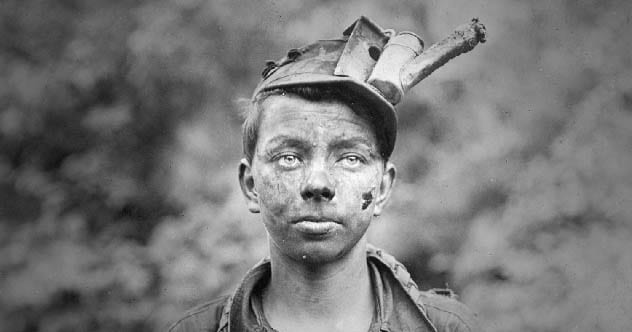Child labor still occurs today; in fact we even wrote a list about it. But going back through the history of Christendom (what we would largely consider the West these days) we see an almost constant use of young boys for the worst jobs we have to offer. Jobs that adult men either didn’t want, or were not equipped for in quite the same way (due to being too big for example). This list takes a trip through relatively recent history to explore ten of the worst jobs we have made our boys endure.
10 Gruesome And Shocking Facts About Victorian Surgery
10 Farming
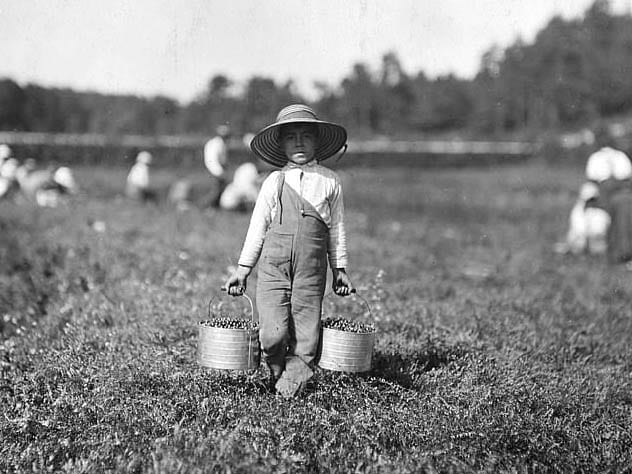
Farming as a job for children remains, to this day, a big part of life on family-owned farms, but in the past children would work wherever they could and for whomever they could. That meant back-breaking laborious hours under the blistering sun being paid a pittance. Without parents in charge, little leniency was offered when a boy fell ill or was overwhelmed by the job. This is an industry that also hired many girls for less arduous jobs such as sorting of fruit and vegetables.
Children provided extremely cheap (and sometimes nearly free) labor for farmers who had profit margins that were minuscule in extremely difficult times. Not only was the depression raging, but the dust bowl was forming and the world was reeling from the aftermath of the Great War . . . and readying itself, perhaps subconsciously, for the next one.[1]
Child labor was largely ended in the US in 1938 as part of the efforts to deal with the Great Depression. It was reasoned that by banning children from work, unemployed men would be able to take up those jobs. Combined with laws to compel the payment of higher wages as well as unionizing efforts in certain industries, it had the desired effect and children were, for the first time in modern history, allowed to be children.
9 Picolo
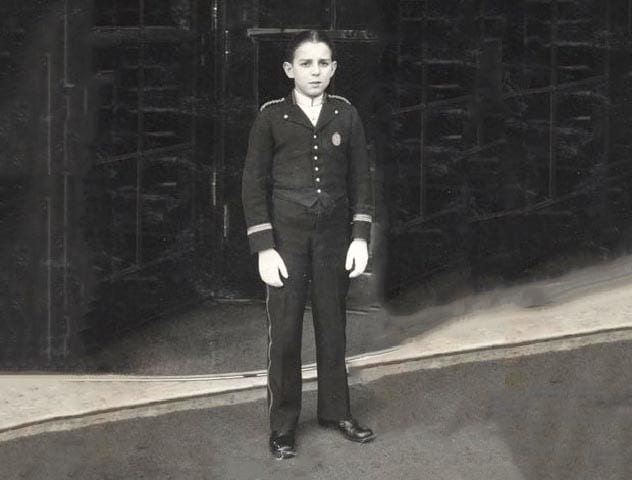
Ludwig Bemelmans, author of the Madeline series of books for children, described the lives of the Picolos in his fantastic book When You Lunch With The Emperor. The book is about his youth as am immigrant boy from Austria working in the New York Ritz during the great depression. The book recounts vivid and seedy tales from the underbelly of the New York Ritz where he worked as a young man during the Great Depression, after emigrating from Austria-Hungary.[2]
“The child picolo is an institution in all European restaurants. His head barely reaches above the table; his ears are red and stand out, because everybody pulls them. And when he is a man he will still pull his head quickly to one side if anyone close to him suddenly moves, because he always did that to soften the blows that rained on him from the proprietor down to the last chambermaid; they hit him mostly out of habit.” He goes on to add: “[W]hen one sees [ . . . ] one of those old waiters [ . . . ] leaning on a chair, with ugly lightless eyes and a dead face that is filled with misery and meanness, one is seeing that little boy grown old, with flat crippled feet on which he has dragged almost to the end of his useless life his dead childhood.”
The picolo worked from 6am till 11pm and his job was to do everything undesirable that no one else wanted to do. He cleaned the ashtrays. He scraped the old food from plates. He folded newspapers, washed dishes, carried water, and spent half the day bowing to his superiors. Despite this, the job of the picolo was, for a boy at the time, not the worst option available to him as we shall see.
The 1993 film King of the Hill (unrelated to the animated TV series) is based on the life of a young boy forced by circumstances to become a picolo. It is considered to be Steven Soderbergh’s most underrated picture, so it is worth a look.
8 Apprenticeships
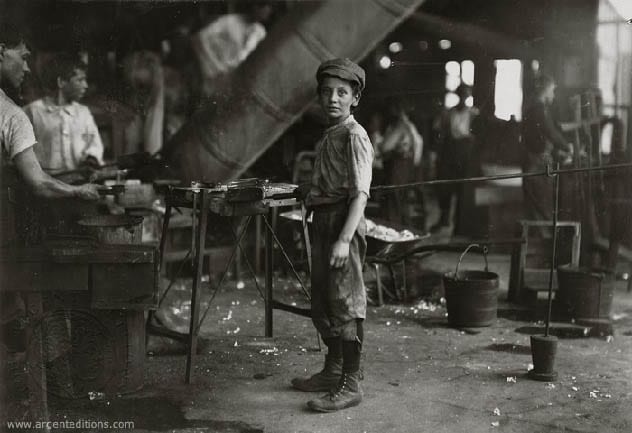
An apprenticeship for a boy typically began between the ages of ten and fourteen. Continuing with the words of Ludwig Bemelmans above: “[T]he picolo was looked upon with envy by the apprentices of plumbers and cobblers; they had the red ears, too, but not enough to eat, and no cigarettes, no drinks, no tips.” Considering that in the middle ages a boy had to pay to become an apprentice, it was something of a novelty that he would even be paid for the job in the 19th and 20th centuries.[3]
Nevertheless, it was difficult work and punishments were liberally delivered by the tradesmen who took these boys on. But, unlike many of the other jobs on this list, there was at least a reasonably certainty that upon competition of your apprenticeship, a good job with an equally good pay awaited you. Such a prospect in such times of hunger and poverty would have seemed a true blessing to the boys “lucky” enough to end up in training. My how the world has changed!
7 Cannery Worker
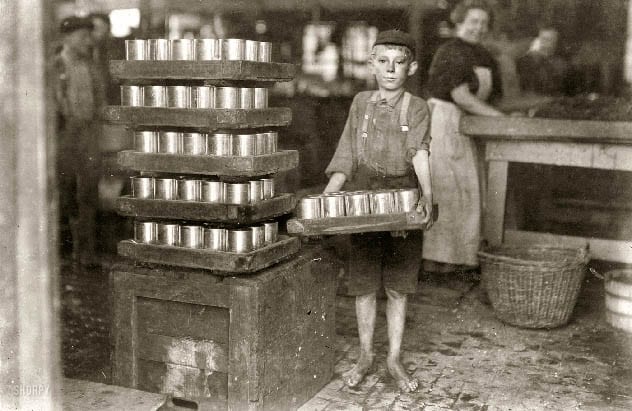
Working in the canneries meant standing for hours in the freezing Atlantic winters chopping, packing, and hauling fish and other foods. Canning was still a fairly young enterprise and like so many other jobs on this list, needed a big workforce of unskilled laborers. Children, like the boy above, aged nine, were paid up to five cents per box that they processed.
Notwithstanding the dangers of working in such terrible conditions (terrible enough for grown men!) the boys were also required to handle extremely dangerous cutting tools and canning machines designed to slice and seal metal. One can only imagine the casualties that would have emerged from the sheds and boatyards where these boys worked.
Unfortunately many of these industries hiring young boys were run by do-gooders. Men (and sometimes women) who felt they were providing a better life for the child by offering them labor. This definitely brings to mind the famous quote of C.S. Lewis who said “Of all tyrannies, a tyranny sincerely exercised for the good of its victims may be the most oppressive. It would be better to live under robber barons than under omnipotent moral busybodies. The robber baron’s cruelty may sometimes sleep, his cupidity may at some point be satiated; but those who torment us for our own good will torment us without end for they do so with the approval of their own conscience.”[4]
6 Bootblack (Shoeshine Boy)
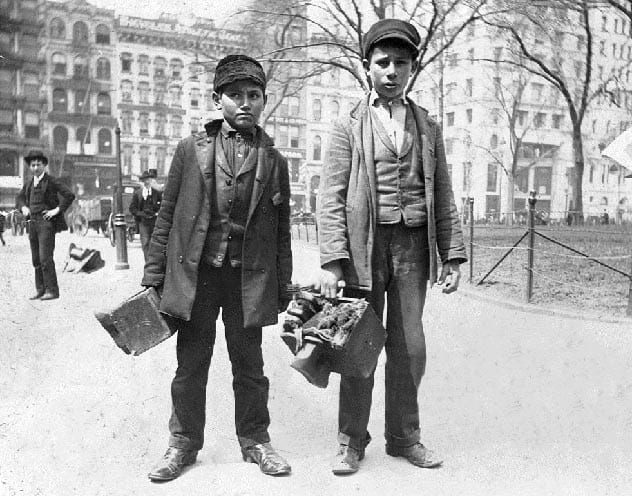
There is an anecdote that tells us that Joe Kennedy (former President Kennedy’s father), upon being given stock tips from a shoeshine boy realized that if a kid who polished dirty old boots for a living could trade stock in the market, it might be time to get out of it! He immediately sold all of his stock and avoided the massive market crash the next day that launched the Great Depression.
Anecdotes aside though, the job of bootblack was a tough one. The boys involved frequently fought others in the same trade for their corner, and you can imagine how vicious that could get when starving children are involved. The job would produce barely enough money to live, and that meant that it was a seven day a week gig, rain or shine. But, for those who were able to acquire the expensive polish and kit needed, it was a far better option than many of the others at the time.
The very first recorded image of a person is that of a man having his shoes polished by a bootblack. The photo was taken in 1838 and you can see it here. The people are in the lower left quadrant. At the time of the photo, Gregory XVI was Pope; he was the last pontiff who was a simple priest when elected (he was ordained a Bishop four days after he became Pope). He was the Pope who condemned and forbade participation in the Atlantic slave trade.
Another bootblack-related fact is that the character of Enoch “Nucky” Thompson in the brilliant television series Boardwalk Empire credited his rapid rise to the reading of the book for boys called Ragged Dick or Street Life in New York with the Boot Blacks. Unlike the characters in the TV Series, the book is real and was written by Horatio Alger Jr. in 1867. It tells the tale of young Dick who starts life as a poor boy on the streets of New York blacking boots, and his lifting himself up through perseverance, thrift, and cleverness.[5]
Ragged Dick’s bildungsroman (coming-of-age story) was immensely popular at the time of publication as it typified the good character that all boys sought to attain. Books such as these epitomized the American dream. I cannot recommend them enough—to modern teenaged boys and grown men alike for the sheer pleasure of their reading. You can buy them here. Ad astra per aspera!
10 Modern-Day Forms of Child Labor
5 Cotton Mill Worker

The invention of the cotton gin, and a variety of other mechanical devices soon after was a Godsend in the post-slavery west. The American civil war and the abolition of the slave trade by Republican president Lincoln led to a shortage of cotton in Europe which verged on a crisis for the nation. But, as life returned somewhat to normal in the states with a new approach to the cultivation and picking of cotton, the industrial inventions brought things back to their peak and beyond.
The new machines were faster than a man, more accurate than a man, but far deadlier. There was a very real risk of loss of life or limb through the use of the cotton gin and spinning machines. Safety mechanisms were not considered important and oversight in the factories was lacking. And, kids being kids, occasional mishaps were bound to happen. Pictured here is twelve year old Giles Newsom in 1912 who had two fingers ripped out of his hand by a spinning machine in the cotton mill. He had slipped and his arm got caught in the gears of the machine. Giles’ eleven year old brother was also working in the factory at the same time.[6]
The reaction from his family to the accident is rather incongruous with our modern principles: “Now he’s jes got to where he could be of some help to his ma an’ then this happens and he can’t never work no more like he oughter.” This apparently-heartless quote from the boy’s aunt underscores how truly important child labor was to family survival in the days before central banking and easy credit. Or, perhaps the aunt was simply sending a message to the mill owner to cough-up bigly in compensation.
4 Soldier
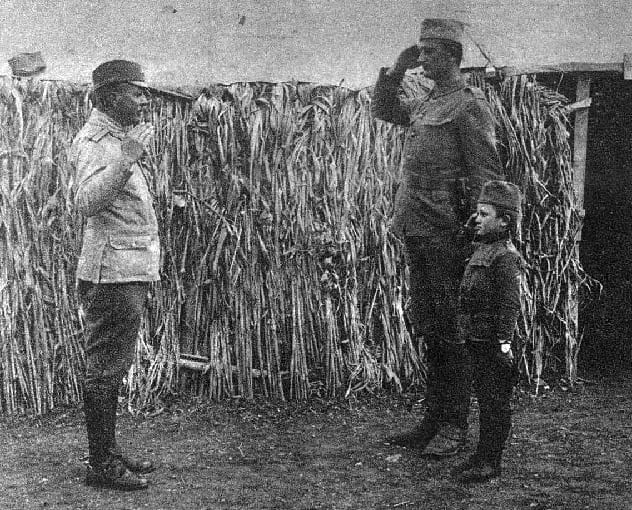
Child soldiers are known to exist today, but this is true going right back to ancient time when the Romans regularly hired boys as young as fourteen for the general army. In recent times (for example El Salvador in the 1990s) boys fought for the rebel troops and many child soldiers were seen across the Balkan region during their troubles.
The most shocking example of an historic nature is that of Momcilo Gavric, the seven year old boy who was accepted into a Serbian army unit and made a corporal a year later at the age of eight. He joined due to being orphaned when his family were killed in the war. He assisted military in the destruction of the troops who had taken the lives of his parents. After the war he was sent to England to school but he returned in time and remained in Serbia until his death aged 86 in 1993. Many monuments have been erected to his memory.[7]
Despite the fairy-tale story of Momcilo Gavric’s life, children in the military is a terrible situation that should be prevented and fortunately most nations (at least western ones) have laws against the use of children in battle.
3 Prostitute
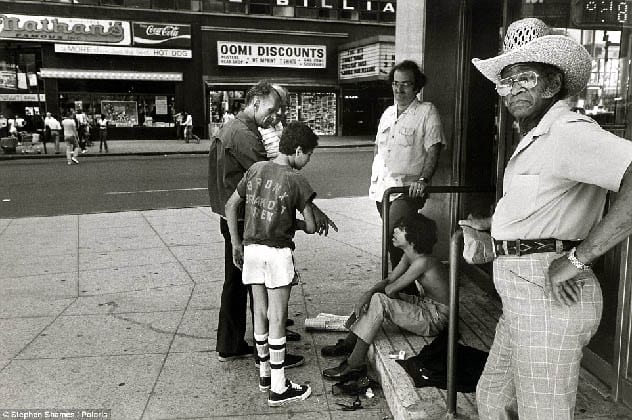
One of the lowest jobs on this list is, tragically, one most frequently seen still today and perhaps performed in even greater frequency than in the past due to the secret nature of many online apps and websites abused for the purpose. Child prostitution is most frequently associated with girls but it is equally common and harmful amongst boys. In Victorian England, Jack Saul caused a scandal when he announced himself, shamelessly, as a “sodomite” and “a professional Mary-ann” in court at the age of 18, admitting to an already long and prosperous career as a rent boy (indicating that he had begun in the profession back in Ireland as a child). Rumors circulated that one of his clients was the handsome Prince Albert, a mere seven years older than he and the eldest grandson of Queen Victoria, then reigning.[8]
Interestingly this is the same Prince Albert who has many times been touted as having been Jack The Ripper. He died at 28 of the Spanish flu pandemic. Prostitution was particularly common amongst Catholic boys in a time when “Papists” were seriously discriminated against in England by law. Additionally, many of the children who took part in this occupation would have been practically enslaved for the purpose by pimps and street gangs. These days many of the boys involved are runaways with very few options for earning money legally due to child labor laws and absent families. Pictured are two boy prostitutes haggling with potential customers in Times Square, New York, in the 1970s.[9]
2 Mine Worker
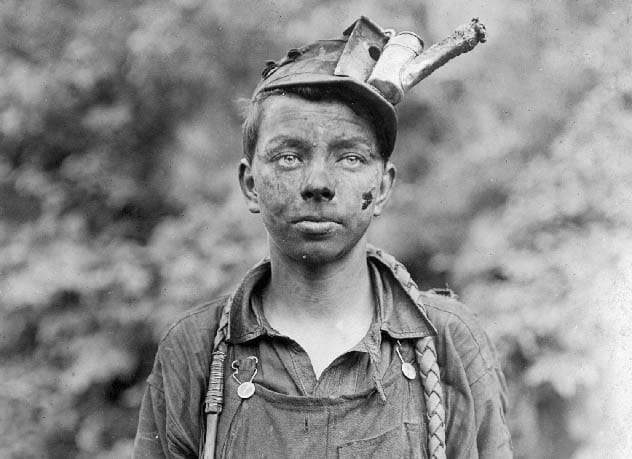
While we are busy fretting over our children playing video games or binge-watching disturbing YouTube videos when they should be out playing in the sun, we should spare a thought for the boys of days gone by who spent their entire childhood deep beneath the surface of the earth performing menial tasks for the men who labored to bring coal to the surface to keep the machinery of the world turning.
These children (such as the boy pictured in 1908 with an oil-wick lamp attached to his cap) worked from 7am to 5:30pm daily in the mines driving the animals that pulled the wagons of coal, opening and shutting doors that kept the miners safe from potential hazards should they arise, or basically performing any task assigned to them that their small bodies or hands were more suited to than those of adult men.[10]
While our children have the promise of a future of opportunities, the boys who worked these mines had no future beyond that of lung disorders and hard labour for a lifetime. And that was the good news; the bad news was that you ran the risk, daily, of being killed by a mine-collapse. The eyes of the child pictured here cannot hide his acute awareness of that fact.
1 Chimney Sweep
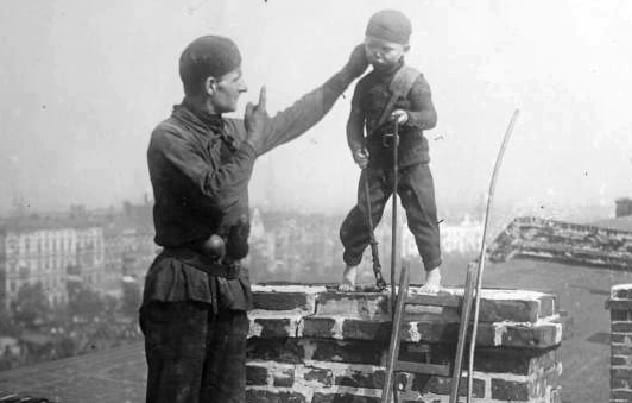
The tragic life of the chimney sweep all too often ended in death. Alas the risk of death was deemed a necessary evil as the lack of clean chimneys would have been catastrophic on a far larger scale for city-dwellers through uncontrolled fires and freezing temperatures. In fact, it was the Great Fire of London in 1666 that led to the adoption of boys (some as young as four) for the task. The little boys were purchased from their parents and forced into tiny chimneys with brushes to do a job that was otherwise impossible due to the sharp angles and considerable length of some chimneys.
On a good day a young chimney sweep would clean chimneys through all the daylight hours, and then retire to a miserable meal sleeping on the floor of his master’s own decrepit lodgings. Standing on top of a roof as he prepared to sweep the first chimney of the day, every day, he would know that the sunrise he was seeing may be his last as there was a very real possibility that this chimney could be the one to finally kill him: by fall, by suffocation, or by becoming stuck tight.[11]
In a horribly sad twist on an already tragic tale, the bodies of many of these innocent children remain entombed throughout London in the chimneys that killed them. There has even been speculation that the British Houses of Parliament are riddled with the corpses of dead boys. Even if the bodies were recovered, a lack of records in a time when the life of a poor boy was worth so little, it would impossible to attribute names to the dead.[12]
An extremely good book on the topic is British Chimney Sweeps: Five Centuries of Chimney Sweeping and I do recommend it if you have an interest in this sordid side of the life of Victorian England.
Top 10 Creepy Aspects of Victorian Life
We Publish Lists By Our Readers! Submit Here . . .
